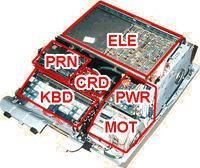The interiors
|
When the case is open, it is immediately clear that
the machine is divided into three large blocks:
|

Click on image for larger view |
The power supply section
is extremely robust in order to provide the machine
with the 350 Watts it requires. This also includes a single electric
motor that, by means of rubber belts, serves all the needs of
the Programma 101 (cooling fan at the rear, card reader, printer
and keyboard).
These rubber belts are the only detail of the machine that
was not designed to last forever. In many cases some of
these belts, made in a very soft rubber, have literally liquified,
transforming themsleves in a sort of awfully sticky black marmalade.
Cleaning this stuff away is painstaking, expecially when it drops
in the very delicate electromechanical section. The same is true
for a single, small cylinder of rubber used in the advancement
of the magnetic card that often sticks together all the very mechanisms
of the reader, including the read/write magnetic head.
The electromechanical
section shows all the previous experience that Olivetti's
engineers had in electromechanical calculators.
The keyboard is quite curious. Usually these keyboards
have a switch behind each key, and all the switches are arranged
in a matrix that is scanned one line at a time by an electronic
circuit. In the Programma 101, instead, behind each key is a small
lever, and all these levers get into a sort of "mechanical
encoder" powered by the motor (fig. 1). This encoder commands
a set of switches. The result of all this is that any time a specific
key is pressed the switches are maneuvered in a specific pattern.
This hardly seems a good idea, and a lot of mechanics is used
to encode the machine's 37 keys to 12 switches, but it must be
taken in consideration that this section also handles priority
encoding (i.e. the contemporary pressure of two keys), keyboard
locking in case of mistake and (as far as I understand) a first
level of key debouncing. The keyboard shows that Olivetti had
a lot of experience with electromechanical calculators
and Ing. Perotto found it easier and more reliable to re-use some
of the know-how that his collegues had in electromechanical keyboards.
The printer is deceiptively simple. A cylindrical drum
rotates behind the paper roll. On the surface of the cylinder
all the printable characters are engraved, repeated on 28 columns,
one for each printable position. In front of the paper is the
ink ribbon, and a single little hammer runs up and down, giving
a hitthe paper at the very exact moment when the cylinder behind
the presents the required character, that gets thus printed.
The manual speaks proudly of the 30 characters per second the
printer is able to handle, and in effects one can see that the
the designers tried to do their best from the fact that each column
in the cylinder has the series of printable characters repeated
twice, so that for each revolution of the cylinder two characters
can be printed.
The card reader is even more simple: a slot to insert
the card, a set of switches to detect the insertion and a magnetic
head. In front of the machine, two switches labeled RECORD
PR and PRINT PR give you all the interface is needed.
Reading a card is simply done by inserting it into the reader
with the RECORD PR switch depressed. Simple as it may seem,
the card reader was extremely advanced
for that period.
The electronic section
is, to put it simply, wonderful. It is well enclosed in a separate
box, with an air filter from one side and a cooling fan from the
other side. At the top is the delay line
memory module with its little driver board. Underneath, 8
large and strictly packed boards are stuffed with discrete components
(transistors, diodes, resistors and capacitors) grouped in small
"modules". For more detail, see the page
about the electronics.
This page is part of the Programma 101 Web
